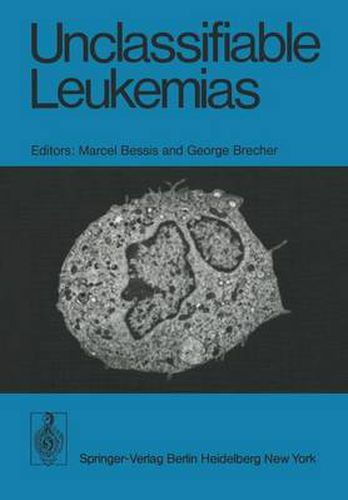Readings Newsletter
Become a Readings Member to make your shopping experience even easier.
Sign in or sign up for free!
You’re not far away from qualifying for FREE standard shipping within Australia
You’ve qualified for FREE standard shipping within Australia
The cart is loading…






This title is printed to order. This book may have been self-published. If so, we cannot guarantee the quality of the content. In the main most books will have gone through the editing process however some may not. We therefore suggest that you be aware of this before ordering this book. If in doubt check either the author or publisher’s details as we are unable to accept any returns unless they are faulty. Please contact us if you have any questions.
Jean BERNARD * I should like to begin with an assumption and a paradox. The assumption is that leukemia is a disease of a stem cell characterized by pathologie alterations of that cell and its progeny. All present research and discussions are centered around the leukemic cell. So is this symposium, which would not take place except for our primary interest in the leukemic cell. This does not preclude, of course, consideration of other definitions and other approaches to the prOblem. By definition, then, the leukemic cells are abnormal cells and their metabolism and functions are presumed to be abnormal. Yet, the classification of the different types of leukemias is based upon the characteristics of normal cells. We talk of lymphoblasts and myeloblasts as predominant cell types in leukemia. This leads to a double paradox. In the first pi ace it is clearly illogical to classify abnormal cells by their resemblance to normal cells, since their very abnormality consists in not being normal. Yet, as a second paradox, the classifica ti on has had the happy consequence of ai ding us in the treatment and prognosis of leukemia for the past 25 years. A more detailed analysis shows that the consequence of this paradox are complex: while there exists a useful correlation between cellular types, treatment and prognosis, numerous problems and difficulties persist. The most serious of them concems the unclassified leukemias which are the reason for this reunion.
$9.00 standard shipping within Australia
FREE standard shipping within Australia for orders over $100.00
Express & International shipping calculated at checkout
This title is printed to order. This book may have been self-published. If so, we cannot guarantee the quality of the content. In the main most books will have gone through the editing process however some may not. We therefore suggest that you be aware of this before ordering this book. If in doubt check either the author or publisher’s details as we are unable to accept any returns unless they are faulty. Please contact us if you have any questions.
Jean BERNARD * I should like to begin with an assumption and a paradox. The assumption is that leukemia is a disease of a stem cell characterized by pathologie alterations of that cell and its progeny. All present research and discussions are centered around the leukemic cell. So is this symposium, which would not take place except for our primary interest in the leukemic cell. This does not preclude, of course, consideration of other definitions and other approaches to the prOblem. By definition, then, the leukemic cells are abnormal cells and their metabolism and functions are presumed to be abnormal. Yet, the classification of the different types of leukemias is based upon the characteristics of normal cells. We talk of lymphoblasts and myeloblasts as predominant cell types in leukemia. This leads to a double paradox. In the first pi ace it is clearly illogical to classify abnormal cells by their resemblance to normal cells, since their very abnormality consists in not being normal. Yet, as a second paradox, the classifica ti on has had the happy consequence of ai ding us in the treatment and prognosis of leukemia for the past 25 years. A more detailed analysis shows that the consequence of this paradox are complex: while there exists a useful correlation between cellular types, treatment and prognosis, numerous problems and difficulties persist. The most serious of them concems the unclassified leukemias which are the reason for this reunion.